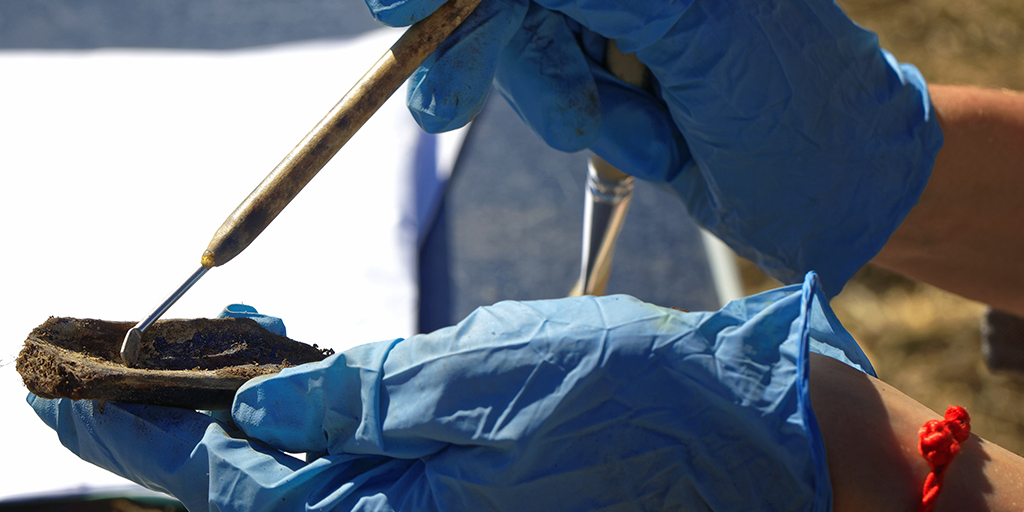The elk tooth is small and ancient, with a crude hole bored through the top. It was likely worn as a pendant, but worn by whom? Was the owner male or female? Where did they come from? Did the pendant indicate their social status, mark a significant accomplishment, was it a gift, or was it worn as an expression of individuality?
Artifacts such as personal ornaments and tools play a pivotal role in helping us understand the migration, behavior and cultures of ancient peoples. To date, this information has stopped short of providing insight into things like the biological sex or genetic ancestry of the individuals who may have worn or used these items, and thus limited our ability to accurately characterize societal roles and behaviors. Recent advances in DNA techniques and technologies, and one little pendant, might be changing that.

Recovering Ancient DNA—The Modern DNA Problem
Isolating usable DNA from ancient items is fraught with challenges including the importance of protecting these precious artifacts, the degraded quality of the target DNA and the risk of contamination from modern DNA sources. In an article published in Nature, a group of scientists describe their success in isolating and sequencing ancient human DNA from a 20,000-year-old elk tooth pendant (1).
The researchers developed the technique specifically to isolate DNA while protecting the integrity of the artifact. The method involves immersing the item in a phosphate buffer and gradually raising the temperature. For their work, the scientist focused on ornamental artifacts that were made from porous substances such as animal bones or teeth. These materials are more likely to have absorbed DNA-containing fluids such as sweat from those who wore them.
Once the DNA was isolated, they created single-stranded DNA libraries and enriched the libraries for mitochondrial DNA (mtDNA) and sequenced the results. Next, they used a metagenomic pipeline to classify the fragments at the mammalian family level.
Initial results using this method on artifacts from archival collections yielded mixed results. The scientist found that DNA isolated from some of the sources showed mammalian DNA with elevated cytosine-to-thymine substitutions at the fragment ends, which is consistent with deamination of cytosine residues that is commonly seen in ancient DNA. Unfortunately, human DNA from modern sources made isolating ancient human DNA much more elusive. They found that every sample analyzed was positive for human DNA, but none of it was consistent with ancient sources. This contaminating modern DNA accounted for between 70.9% and 98.3% of the identified mtDNA fragments. The abundance of modern human DNA presented a problem because it could potentially mask the presence of any ancient human or animal DNA.
Handled with Care
The breakthrough came in the form of that small pendant made from an elk tooth. The pendant, unlike the other objects tested, was excavated using procedures that would protect it from contamination. Everyone who handled the pendant wore protective equipment from the moment the artifact was uncovered. As a result of these precautions, modern DNA was notably absent from the isolated mtDNA, while mtDNA from wapiti (an elk species) and human sources were present.
The mtDNA from the single-stranded DNA library for this sample was further enriched using a set of human-specific capture probes. The resulting mtDNA library yielded a 62-fold average coverage of human mtDNA genome. From it, they were able to obtain a nearly complete consensus sequence.
The mtDNA sequence contained positions that are “diagnostic”, meaning that they allowed the mtDNA obtained from the pendant to be distinguished from mtDNA sequences of other humans. The number of overlapping fragments at these positions suggests that most of the DNA collected was from a single source, and she was female.
Who Was She?
Although we can’t know for sure, the woman was most likely the user or maker of the pendant. Nuclear DNA analysis and genetic comparisons show that she had close genetic ties to an ancient northern Eurasia people who lived approximately 17,000–24,000 years ago. Evidence of these people had previously only been found further east in Siberia. This genetic profile broadened our understanding of this people’s geographic range while simultaneously enhancing our understanding of who the mystery woman might have been.
The Past’s Future
In a world where you can send away a kit in the mail, spit in a tube and find unknown genetic relatives within weeks, these results might seem easy to dismiss as nothing new. That is far from the case; the implications of these results are mind-boggling. Imagine holding a tooth pendant in your (gloved) hand and being able to discover that the last person who touched it with any regularity was a woman who lived around 20,00 years ago. This study shows that, if handled properly during excavation, ancient tools and ornaments crafted from bone or teeth could yield not just human DNA, but individual-specific genetic knowledge about the ancient person who handled them. Think how this knowledge could dramatically drive our understanding of ancient cultures forward.
Reference
- Essel, E. et al. (2023) Ancient human DNA recovered from a Paleolithic pendant. Nature Published online May 3, 2023. Accessed May 22, 2023.
Related Posts
Kelly Grooms
Latest posts by Kelly Grooms (see all)
- Growing Our Understanding of Triple-Negative Breast Cancer in Sub-Saharan Africa: Why Comprehensive Population Data Matters - June 5, 2025
- Measles and Immunosuppression—When Getting Well Means You Can Still Get Sick - April 17, 2025
- IC50, EC50 and Kd: What is the Difference and Why Do They matter? - March 6, 2025
